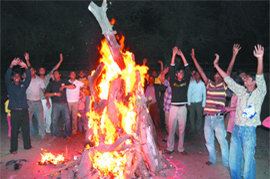” No one is gonna play with water this holi ” I ordered my sister. In return she said ” Why not? Even you played with water as a child” To which I replied ” Yeah! That is right, but I did so because at that age I was not aware of how I was wasting water by playing holi. ” She quickly claimed to be ‘ not-so-grown-up’ to understand that now. And after that whenever i tried to convince her she had different counter arguments making me understand that no matter how hard i try they wont refrain from using water.
I have have been learning since childhood that “India is a land of festivals and Indians celebrate each and every festival together with unity.” And tomorrow Indians are proudly gonna celebrate ‘Holi’. Before I put forward my views I would like to talk about what is this festival all about..
HOLI– It is celebrated by Hindus on the last full moon day of the lunar month phalguna which usually falls in the later days of February or March. The main day, known as dhulendi, is celebrated by people throwing coloured powder and coloured water at each other. Bonfires are lit the day before, also known as Holika Dahan or choti holi.
The bonfires are lit in memory of the miraculous escape that young Prahlad accomplished when Demoness Holika, sister of Hiranyakashipu, carried him into the fire. Holika was burnt but Prahlad, a resolute devotee of god Vishnu, escaped without any injuries due to his unshakable devotion.
The most celebrated Holi is that of the Braj region, in locations connected to the Lord Krishna: Mathura,Vrindavan, Nandgaon, and Barsana. In Mathura and Vrindavan, the celebration lasts for 16 days in commemoration of the divine love of Radha for Krishna.
Traditionally, the coloured powder was extracted from ayurvedic sources like neem, kumkum, haldi, bilva and others of the kind. For coloured water, flowers of Palash were boiled and soaked in water over night to produced yellow coloured water which had medicinal properties.
Unfortunately, the use of herbal Colours had been replaced by synthetic dyes being used now-a-days for playing holi. These colours are not only the cause of various diseases but also have a great impact on environment. “Synthetic colours pollute water.”
Holi, a day when people unnecessarily waste gallons of water ( by throwing at each other ) and then pollute the rest cleaning themselves. If for a while we keep aside all other aspects and consider only the water issue, we come to know that it is indeed a big threat in itself.
I, as a child, played holi with all my friends in my neighbourhood and today when I look down the memory lane I feel disappointed that at that time there was no one who taught me to adopt alternative methods of celebrating the festival of colours and to try not to harm the mother earth. But today, When I am mature enough to understand I feel sad for those who don’t. Leave aside them who don’t understand but what about those who know but are ignorant?
As I said in the beginning that I tried to persuade my sister to play holi with dry powder but I could not convince her appropriately. In fact, even my parents asked me to stop ‘interfering’ and its ok if children go out and enjoy themselves. Backed by support from my mother and because of obstinate attitude of my sister, today she and her friends wasted a whole lot of water. *sigh!*
I really wish people understand their responsibilities towards environment and start taking initiative. I wish people stop thinking that Why should i stop when others are doing the same?
Just like one light ray can turn out darkness one mild effort can make a difference.



